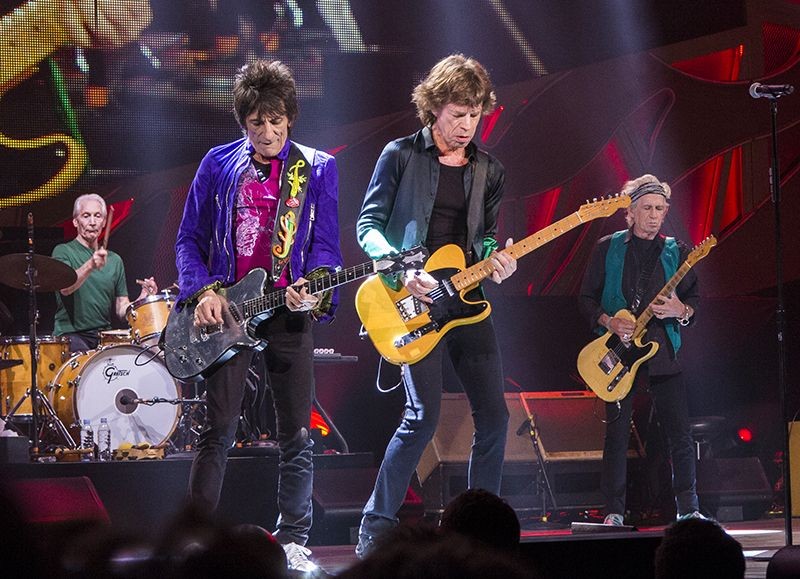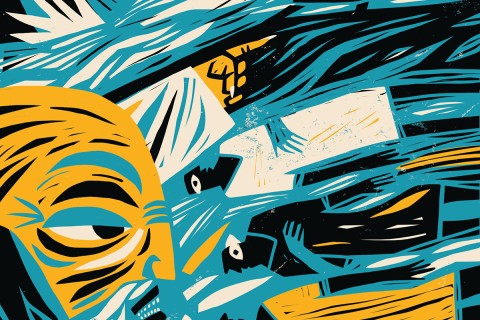Time waits for no one
I went to see the Rolling Stones play again—and revisited an adolescent fantasy.

After 25 years, one traffic jam, two flight delays, and a long crawl through a crowded city park, my brother and I didn’t want to be late. We had tickets to the Rolling Stones in Chicago, a concert that had become the opening of their current tour after the delay caused by Mick Jagger’s heart valve replacement. The showtime was 7:30 p.m., which we had no hope of making. At first I didn’t expect this to be a problem. There was an opening act, and the Stones have never been known for punctuality. But as the delays piled up I started to worry: What if they’d changed? What if they (and their audience) now needed a bit more promptness and an earlier conclusion?
Finally we reached the gate, the flood of fans long having ebbed to a trickle. We made our way to our expensive but still quite distant seats, which were already occupied. We sorted that out and turned to face the stage just as the first thunderous chords of “Street Fighting Man” began and the four towering screens lit up with a stylized shot of the bridge of Keith Richards’s Fender Telecaster. We were an hour and fifteen minutes late, but we ended up right on time.
The improbable, then slightly comical, and now just stupefying endurance of the Rolling Stones is built on four albums and a handful of singles released from 1968 to 1972. They made some great music and had some big hits after and especially before those years. But it’s that period that distinguishes the Stones from the nostalgia acts confined to airways, playlists, and state fairs.
It’s not just that it’s their best recorded output, though Beggar’s Banquet, Let it Bleed, Sticky Fingers, and Exile on Main Street are universally acknowledged as the peak of their creativity and a sudden leap forward in their musical virtuosity. It’s also music that performs well: thrillingly, with endless room for variation and surprise built right into the structures of the songs. These were also the years when the band nearly fell apart, when a founding member was kicked out of the group and suddenly died, when their own unmanageable fame and ungoverned vices became major liabilities for themselves and people around them, and when numerous fellow rock-and-roll pioneers succumbed to addiction or misadventure. In Chicago, 10 of the 19 songs they performed came from that four-year slice of the band’s 50-year recorded catalog.
But they made it through and kept working, more or less. Since 1981 the Stones have been a touring act first and a recording act second (or even third, behind their merchandising and branding operation). Their golden age was over well before I was born. But I started collecting those albums (remastered and reissued on CD) as the Stones were in this strange, deferred silver age as performers. Their newer albums still offered some tracks that would have stood on their own, without the burden and credentialing of a legendary history. They even offered some moments of unexpected self-awareness. “I do believe in miracles, and I want to save my soul / But I know that I’m a sinner—I’m gonna die here in the cold,” Mick sings on “Saint of Me,” a 1997 song with left-field references to Paul and Augustine.
But the Stones would have been able to make themselves into a globe-spanning behemoth even without such flashes of brilliance in their more recent material. That’s because they could still play. When my brother and I saw them for the first time in 1994, they were probably performing better than they were in the mid-70s. And that touring behemoth underwrote an adolescent and young-adult fandom that never really ended. Like a million other fans, I sat in my basement room learning “Honky Tonk Women” and “Sympathy for the Devil” note-for-note. Then I varied them to suit with my high-school garage band. The Stones kept finding new ways to do it, so I might as well, too.
Adolescent fantasies die slowly. The Stones themselves began as just kids who wanted to play Chuck Berry and Muddy Waters tunes. They didn’t plan to end up as inescapably enmeshed gears in a vast engine of commerce and fame that grinds on nearly 60 years later. In my youth I wanted desperately to play guitar for a living, but eventually my neurotic pursuit migrated from music to religion and I’ve never once regretted it. Not that I could put the guitar down completely. At a potluck on the night after my ordination I sang “Dead Flowers” with a local country band, a choice my bishop mordantly observed was rather fitting. During VBS I still take great joy in turning the radio-pop Group songs into rockabilly scorchers with a couple other guys.
But those are strictly nostalgia trips. The Stones kept on going, taking our money and showing up and unleashing those big chords into the night air on our behalf. They looked the part of strung-out rebels long after they gave up their needles and spoons and even after Keith was ordered by his doctors to give up cocaine. Unlike the rest of us, they got old without having to grow up.
Still, their performance in 2019 was a marvel. The quarter-century since I saw Mick Jagger last has been harder on me than on him. As far as I could tell, they haven’t had to transpose any of their songs into easier keys for singing, as road warriors from Robert Plant to Billy Joel have done. Guitarist Ronnie Wood was spry and impish on stage as usual, and while he has a fairly light workload on some of the songs, he solos as well as ever. Drummer Charlie Watts looks virtually unchanged. He sat impassively in the middle of it all—in interviews he’s been notably lukewarm about the band’s work—and only cracked a few wide smiles when the songs really took off.
Keith Richards was another story. He used to look grizzled but animated, but in Chicago he mostly just stood there, staring at his guitar and letting the spaces between the notes do more work than usual. “Gravitas” is what one reviewer called it, with ludicrous generosity. “He picked his battles on that one,” my brother observed during “Sympathy for the Devil.” “Midnight Rambler” nearly broke to pieces; it was hot, but it was also one Charlie Watts away from sounding like some suburban dads screwing around in the basement after a few beers. There were moments when Richards seemed lost. But when he found it, the songs roared to life.
That’s what we come to these mammoth, preposterous shows for: a moment that hangs there before the chorus, and then a feeling of dissolving into a huge crowd singing “you can’t always get what you want” together. The quasi-religious echoes in these stadium spectacles are the stuff of cliche, but this was the first time I really felt it for myself: that strange combination of individual and collective experience mediated through layers of variation and in-group humor. Each of us there was just the latest in a line of selves that have handed that song along, one to the next, from the suburban home stereo or car radio where it began for us. Someone in the row behind us saw me flailing with my phone between songs and took our picture, grinning and almost bug-eyed with recovered adolescent delight. We came late to the show, but as ever, the Rolling Stones were waiting for us.





